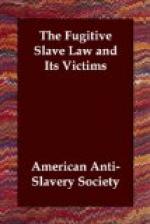him to be delivered up to the claimant. Some four
hours were consumed in getting Court Street, State
Street, &c., in a state of readiness for the
removal of the prisoner. A regiment of Massachusetts
Infantry had been posted on Boston Common, under
command of Col. Benjamin Franklin (!) Edmands,
from an early hour of the day, in anticipation of
the Commissioner’s decision. These
troops, which had been called out by the Mayor,
Jerome V.C. Smith, were marched to the scene
of the kidnapping, and so placed as to guard every
street, lane, and other avenue leading to State
Street, &c., the route through which the slave
procession was to pass. No individual was
suffered to pass within these guards; but acts of
violence were committed by them on several individuals.
Court Square was occupied by two companies of
United States troops, (chiefly Irishmen,) and
a large field-piece was drawn into the centre.
All preparations being made, Watson Freeman (United
States Marshal) issued forth from the court-house
with his prisoner, who walked with a firm step,
surrounded by the body-guard of criminals before
mentioned, with drawn United States sabres in
their hands, and followed by United States troops
with the aforesaid piece of artillery. Preceded
by a company of Massachusetts mounted troops,
under command of Colonel Isaac H. Wright, this
infamous procession took its way down Court Street,
State Street and Commerce Street, (for the proprietors
of Long Wharf refused to allow them to march upon
their premises, through a public highway in all ordinary
cases,) to the T Wharf, where the prisoner was
taken on board a steam tow-boat, and conveyed
down the harbor to the United States Revenue
Cutter Morris; in which he was transported to Virginia.
It may not be amiss to have given, in a single instance, this somewhat detailed account of the process of seizing, trying, and delivering up a man into slavery, whose only crime was that he had fled from a bondage “one hour of which is fraught with more misery than ages of that which our fathers rose in rebellion to throw off,” Thomas Jefferson, the Virginian slaveholder, himself being witness.
Anthony Burns, having
been sold into North Carolina, was
afterwards purchased
with money subscribed in Boston and
vicinity, for the purpose,
and returned to Boston.
The illegality of the Mayor’s conduct in ordering out the military, and giving to the Colonel of the regiment the entire control of the same, was fully shown by different and highly competent writers, among whom was P.W. Chandler, Esq., whose two articles, in the Boston Advertiser, deserve to be remembered with respect. The Mayor’s excuse was that he desired to keep the peace. But these Massachusetts troops received pay for their day’s work from the United States Government. Judge HOAR, in a charge to the Grand Jury, declared the act of the Mayor, in calling out the militia, to be




